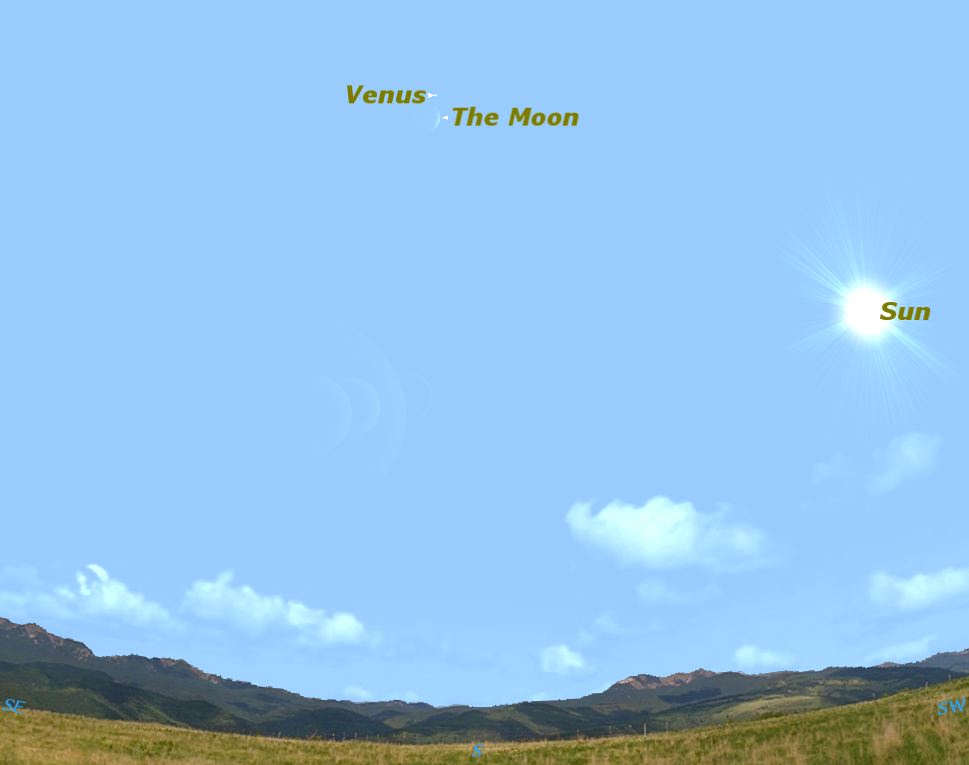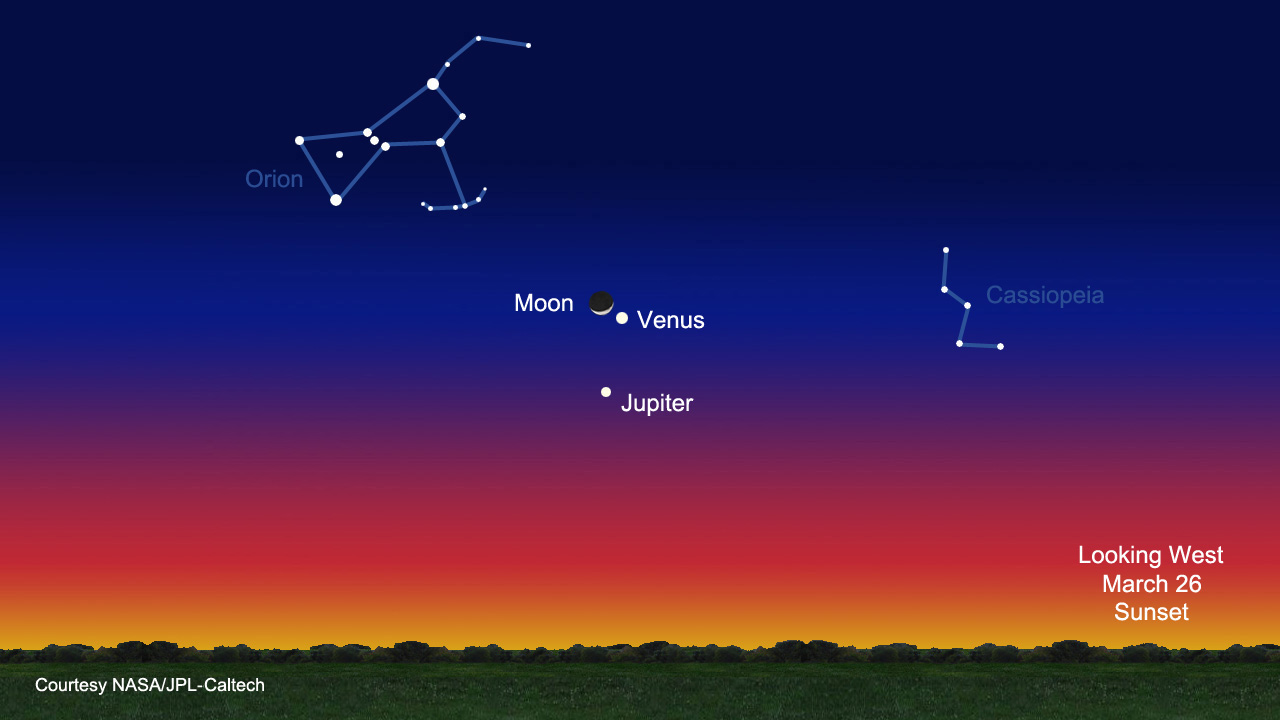Planet Venus Visible in Daytime Sky Today: How to See It (original) (raw)

This sky map shows how to spot Venus in daylight on Monday, March 26, 2012. WARNING: Never look directly at the sun with your unaided eye or through binoculars or telescopes without special light filters. Severe eye damage can result. (Image credit: Starry Night Software)
The planet Venus has been dominating the nighttime sky recently, but did you know it's possible to see the bright world in the daytime? Today (March 26), Venus can be spotted in the afternoon if you know where and when to look.
In fact, a daytime apparition of Venus in the sky was famously spotted by none other than President Abraham Lincoln in 1865.
It was March 4, 1865, and the streets of Washington DC were packed with crowds watching the inauguration ofAbraham Lincoln for his second term as president. Suddenly someone in the crowd spotted something strange in the sky: a tiny brilliant point of light. Excitement swelled through the crowd as each person pointed it out to their neighbor. The commotion even reached as far as the Lincoln himself, and soon he too was pointing at the brilliant point in the sky.
One of Lincoln's bodyguards, Sergeant Smith Stimmellater, described it this way: "Soon after the President concluded his address, he entered his carriage, and the procession started up Pennsylvania Avenue to the White House, the escort from our Company following next to his carriage. Shortly after we turned onto Pennsylvania Avenue, west of the Capitol, I noticed the crowd along the street looking intently, and some were pointing to something in the heavens toward the south. [Great Skywatcher Photos of Venus and Jupiter]
"I glanced up in that direction, and there in plain view, shining out in all her star-like beauty, was the planet Venus. It was a little after midday at the time I saw it, possibly near one o'clock; the sun seemed to be a little west of the median, the star a little east. It was a strange sight. I never saw a star at that time in the day before or since. The superstitious had had many strange notions about it, but of course it was simply owing to the peculiarly clear condition of the atmosphere and the favorable position of the planet at that time. The President and those who were with him in the carriage noticed the star at the same time."
This week, nearly a century and a half later, you can duplicate this famous observation. The sky map of Venus in daylight for this story shows where Venus and the moon will appear at 4 p.m. relative to the sun.
Venus is quite easy to see in a clear blue daylight sky, if you know exactly where to look, and if you can focus your eyes on it. What makes today's Venus appearance special is that the waxing crescent moon will be right next to Venus in the sky, showing you exactly where to look, and giving your eyes something to focus on.
Breaking space news, the latest updates on rocket launches, skywatching events and more!
Here's how to see it:
Go out around 4 p.m. local time on Monday, and position yourself so that the sun is behind a chimney or rooftop to your right. Blocking the sun is always essential if you're looking anywhere close to the sun. WARNING: Never look directly at the sun with your unaided eye or through binoculars or telescopes without special light filters. Severe eye damage can result.
Then face due south, and look two-thirds of the way up the sky towards overhead. If the sky is clear, you should be able to clearly see the crescent moon. Look just above the moon, and you should be able to see Venus as a tiny brilliant pinpoint of light.
If you have difficulty, try using binoculars to focus on the moon. Before using binoculars, make doubly sure that the sun is still safely behind the chimney or rooftop. Always take extreme care when using binoculars in a daytime sky and never point them at the sun without using a solar filter.

This NASA sky map shows the positions of Venus, Jupiter and the moon on March 26, 2012 during a potentially spectacular conjunction of the three objects. (Image credit: NASA/JPL/Jane Jones)
Venus is not the only object currently shining bright in the evening and nighttime sky. Tonight, Venus will appear near the moon and Jupiter for the second night in a row in an event that astronomers call a conjunction.
At sunset tonight, Venus will appear in the west just to the right of the crescent moon with Jupiter shining below. In the eastern night sky, Mars is also currently visible at night and is unmistakeable due to its reddish hue.
If you snap an amazing photo of Venus and Jupiter, or any other skywatching target, and would like to share it for a possible story or image gallery, please contact SPACE.com managing editor Tariq Malik at tmalik@space.com.
This article was provided to SPACE.com by Starry Night Education, the leader in space science curriculum solutions. Follow Starry Night on Twitter @StarryNightEdu .
Join our Space Forums to keep talking space on the latest missions, night sky and more! And if you have a news tip, correction or comment, let us know at: community@space.com.
Geoff Gaherty was Space.com's Night Sky columnist and in partnership with Starry Night software and a dedicated amateur astronomer who sought to share the wonders of the night sky with the world. Based in Canada, Geoff studied mathematics and physics at McGill University and earned a Ph.D. in anthropology from the University of Toronto, all while pursuing a passion for the night sky and serving as an astronomy communicator. He credited a partial solar eclipse observed in 1946 (at age 5) and his 1957 sighting of the Comet Arend-Roland as a teenager for sparking his interest in amateur astronomy. In 2008, Geoff won the Chant Medal from the Royal Astronomical Society of Canada, an award given to a Canadian amateur astronomer in recognition of their lifetime achievements. Sadly, Geoff passed away July 7, 2016 due to complications from a kidney transplant, but his legacy continues at Starry Night.